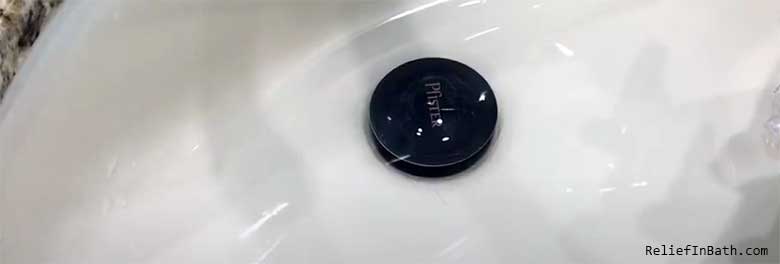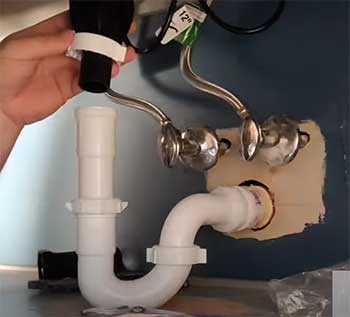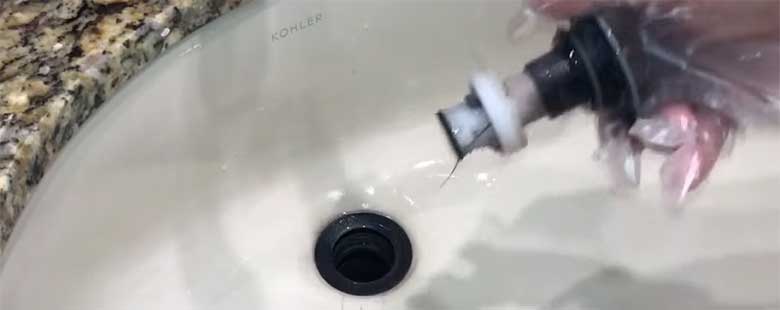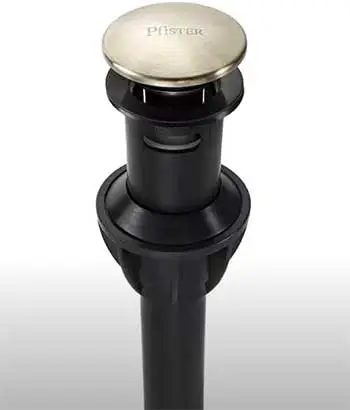Every modern home has sinks in the kitchen and bathroom. Nowadays, sinks come with elegant designs and various functions. But it becomes a severe problem when a sink doesn’t work properly.
If your Pfister sink stopper won’t stay up, don’t fret, because it is a common problem, and most of us don’t know the easier ways to solve it.
If you also want to have a solution to this problem, go through this article. In this article, you will find the probable reasons and solutions to repair a Pfister sink stopper that won’t stay up.
Why Does Pfister Sink Stopper No Longer Stay Up?

There are some major culprits that might cause this problem. Let’s deep dive and find out the probable reasons –
- Clogging
This is one of the main reasons for the sink stopper not staying up. Not only this problem, but clogs of the sinks can also cause various other issues.
Pfister’s push and seal drain stoppers work almost like a pop-up drain stopper. There is a spring located inside the stopper. So when you push the stopper, the spring locks the drain and holds the water.
Again, when you push back the stopper, it pops up and clears the path.
When hair and other build-up get clogged inside the spring, it affects the spring mechanism of the sink stopper.
The spring can’t compress and expand because of this hair, and eventually, the spring gets broken or doesn’t work correctly. So if you notice that your Pfister sink stopper is not standing up, check for the clogging first.
- Faulty Pivot Rod

The pivot rod helps you to open and close the sink drain just with pushes. Before pop-up sink stoppers came into the market, people used to use rubber stoppers to hold the water in their sink.
But rubber stoppers had many problems like leakage, easily worn out, etc.
Pivot rod solved this problem very effectively. Push and pull, pop-up sink stoppers are very popular nowadays because of their pivot rod mechanism.
When you push the stopper, the pivot rod goes up and closes the drain. On the other hand, when you push back the sink stopper or pull the stopper (in the case of push and pull stoppers), the pivot rod goes down and clears up the drain.
But if anything happens to this pivot rod, your stopper won’t work perfectly. So, that can be a reason for your problem.
- Loose Linkage Nut
A loose linkage nut might be another reason for your Pfister sink stopper not staying up. Now the question is how to know that the linkage nut of the sink stopper is loose?
To make sure your sink stopper’s linkage nut is loose or not, you have to look underneath the sink where the main water supply line is connected with the faucet line.
Inspect the linkage system properly as well as the joints. If you feel that the nut of the linkage system is a little bit loose, that might be causing the problem.
The linkage nut gets loose for mainly two reasons. If your faucet is very old and you have been using it for a long time, it can get loose.
Another reason could be that someone accidentally rotated it. Whatever the reason is, check the linkage nut whenever you face a problem with your sink stopper.
- Worn-out Rubber Seal
Pop-up, push and seal, push and pull – all these sink stoppers have one thing in common: the rubber seal underneath the cap or the lid.
The rubber seal is an important part of the sink stopper because it prevents leakage. But a worn-out rubber seal can be the reason why your Pfister sink stopper won’t stay up.
How To Fix A Sink Stopper That Won’t Stay Up?

You must be thinking about fixing your Pfister sink stopper that won’t stay up, right? Here are some easy solutions for you to fix the problem –
- Check for Clogs
As discussed earlier, clogging in your sink stopper can be a major problem. So if you notice that your sink stopper is not standing as it is supposed to, you should first check for clogs.
Remove the cap of the sink stopper and rotate the stopper. Use a pair of pliers to rotate it. Then check inside and clean the hair and other build-ups from the spring.
To unclog it, you can watch this video as well.
- Reassemble the Pivot Rod
If the pivot rod is broken, then the sink stopper won’t stay up. Because the pivot rod maintains the main mechanism of a sink stopper.
Reassembling the pivot rod is the best way to solve this problem.
First, remove the pivot rod from the sink drain. You will see that a lift rod and a lift strap connect vertically with the pivot rod. Inspect the pivot rod, lift rod and strap carefully.
If you find any fault in any of these three parts, change it and adjust a new one.
Make sure you tighten the nut that connects the stopper with the pivot rod. Usually, the main body of Pfister sink stoppers is made of plastic, so you won’t need any tool to tighten the nut.
- Change the Spring and Rubber Seal
Before removing all the inside parts, check the rubber seal, which stays underneath the cap of the sink stopper. The rubber seal might be worn-out or lost. Check for the spring also.
A broken spring can also cause the problem. Change the spring or the faulty rubber seal and install a new one.
- Tighten up the Linkage nut
We discussed earlier how you can find the linkage nut and inspect if it’s loose or not.
Most of the Pfister sink stopper pivot or linkage nut is made of plastic. So you can tighten the nut by just using your hands.
But if you find it difficult, take a wrench and rotate the nut until you feel that it’s tight enough. And there you go, it is all done!
Installing A New Universal Stopper
If you can’t find replacement parts for your Pfister sink stopper, or just want to upgrade, installing a new universal stopper is an easy option.
Here’s how to swap it out:
Supplies Needed:
- Universal sink stopper
- Adjustable wrench
- Plumber’s putty or silicone sealant
Steps:
- Remove existing stopper assembly. Unscrew the retainer nut and take out all parts. Clean sink surface thoroughly.
- Apply plumber’s putty. Roll plumber’s putty rope and press around the sink drain opening. This seals the new stopper.
- Install new stopper. Insert stopper in drain hole, aligning over threads. Tighten retainer nut underneath to secure in place.
- Remove excess putty. Wipe away any excess putty squeezed out around the stopper. Let dry before using.
- Test stopper function. Fill sink with water and test raising and lowering the stopper. Ensure it moves smoothly and seals closed.
Universal sink stoppers come in a variety of styles and materials like chrome, brass, or silicone. Choose one that fits your faucet’s look. Installation takes just a few minutes.
Is Pfister Sink Stopper Worth It?
Pfister is a well-known company that mainly manufactures bathroom and kitchen faucets, shower systems, and accessories. Their faucets come with different types of sink stoppers.

Push and seal, pop-up sink stoppers are Pfister’s most popular sink stoppers.
But people face difficulties with their sink stoppers sometimes. One of the major problems they face is that the sink stopper won’t stay up.
The mechanism of the modern sink stopper is a little bit complicated but it is very easy to use.
But the problem starts when the sink stopper won’t stay up no matter how much you pull the stopper. Therefore, it blocks the drain, and the water gets stuck. This could be really annoying sometimes.
In this article, we will discuss this specific problem of Pfister sink stopper and demonstrate all the solutions to fix this problem.
Preventing Future Pfister Stopper Issues
To help your new or repaired Pfister sink stopper continue working smoothly, follow these maintenance tips:
- Periodically clean stopper assembly with vinegar and water to remove mineral buildup.
- Every few months, lubricate moving parts with silicone grease or waterproof oil.
- Avoid damaging the lift rod by not pulling up too forcefully.
- If water is slow to drain, detach and thoroughly clean the stopper mechanism.
- Replace any parts that become worn, rusted or damaged right away.
With proper care, your Pfister sink stopper can work like new for years of hassle-free daily use.
FAQ: Pfister Sink Stopper Issues
Tighten the clevis under the sink to increase pivot rod tension.
Replace any worn out or broken parts of the popup assembly.
Install a new universal sink stopper.
The tailpiece threads or nut may be stripped, preventing a tight seal. Replace any damaged pieces.
Debris, hair or other gunk may be caught under the stopper, propping it open. Thoroughly clean the assembly.
The pop-up mechanism is broken or detached. Repair or replace the assembly.
The stopper silicone or rubber seal is worn out. Replace the stopper.
Stopper is not fully reattached after cleaning. Tighten the retainer nut.
Debris or defective stopper seat is preventing a seal. Inspect and clean sink surfaces.
There is too much tension on the lift rod or pivot rod. Loosen the clevis nut slightly.
The stopper is undersized and getting pushed up by water pressure. Replace it.
Gunk buildup is sticking to the stopper and pulling it up. Clean thoroughly.
Final Words
Any problem in your household can be so frustrating when you don’t know how to fix it. If your Pfister sink stopper won’t stay up, it is nothing new of an issue for the product. Many people have faced it.
You don’t have to spend money on professional services if you know how to solve this on your own. Just find the exact reason first and then pick the suitable solution accordingly.
